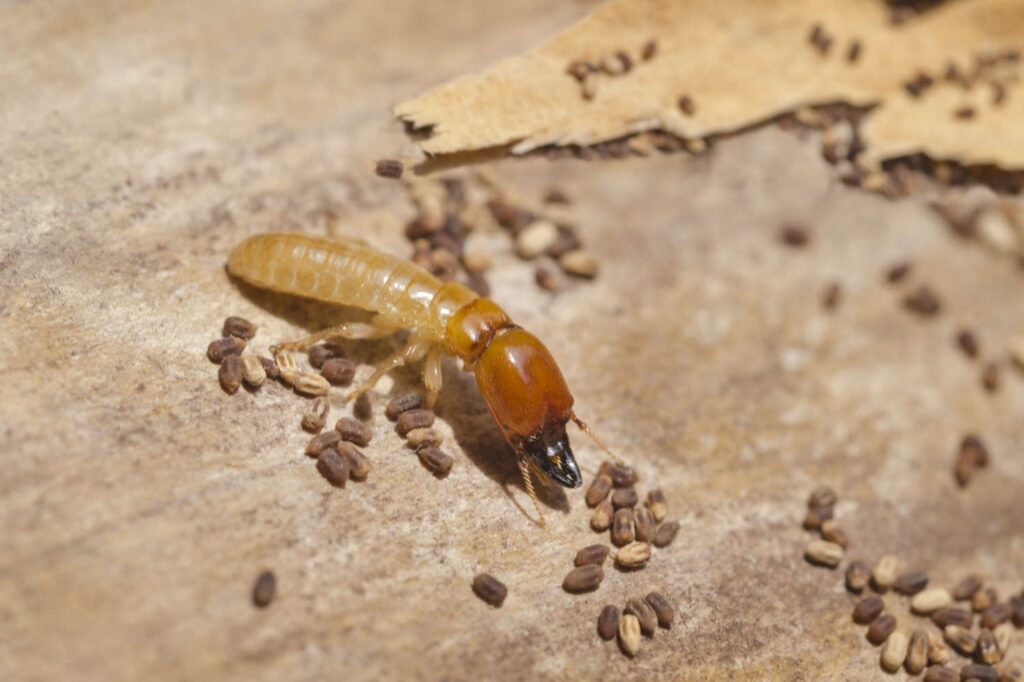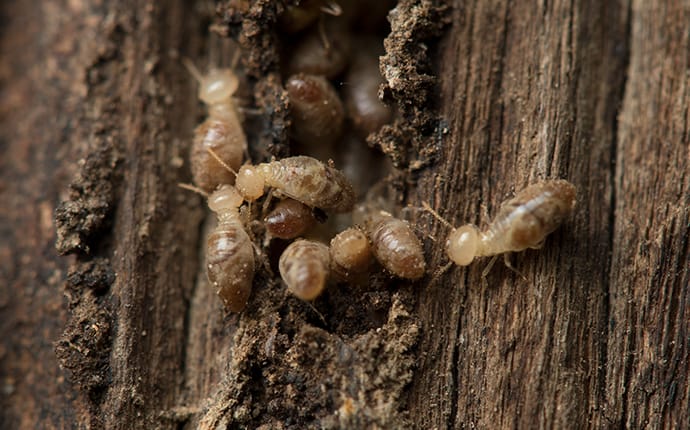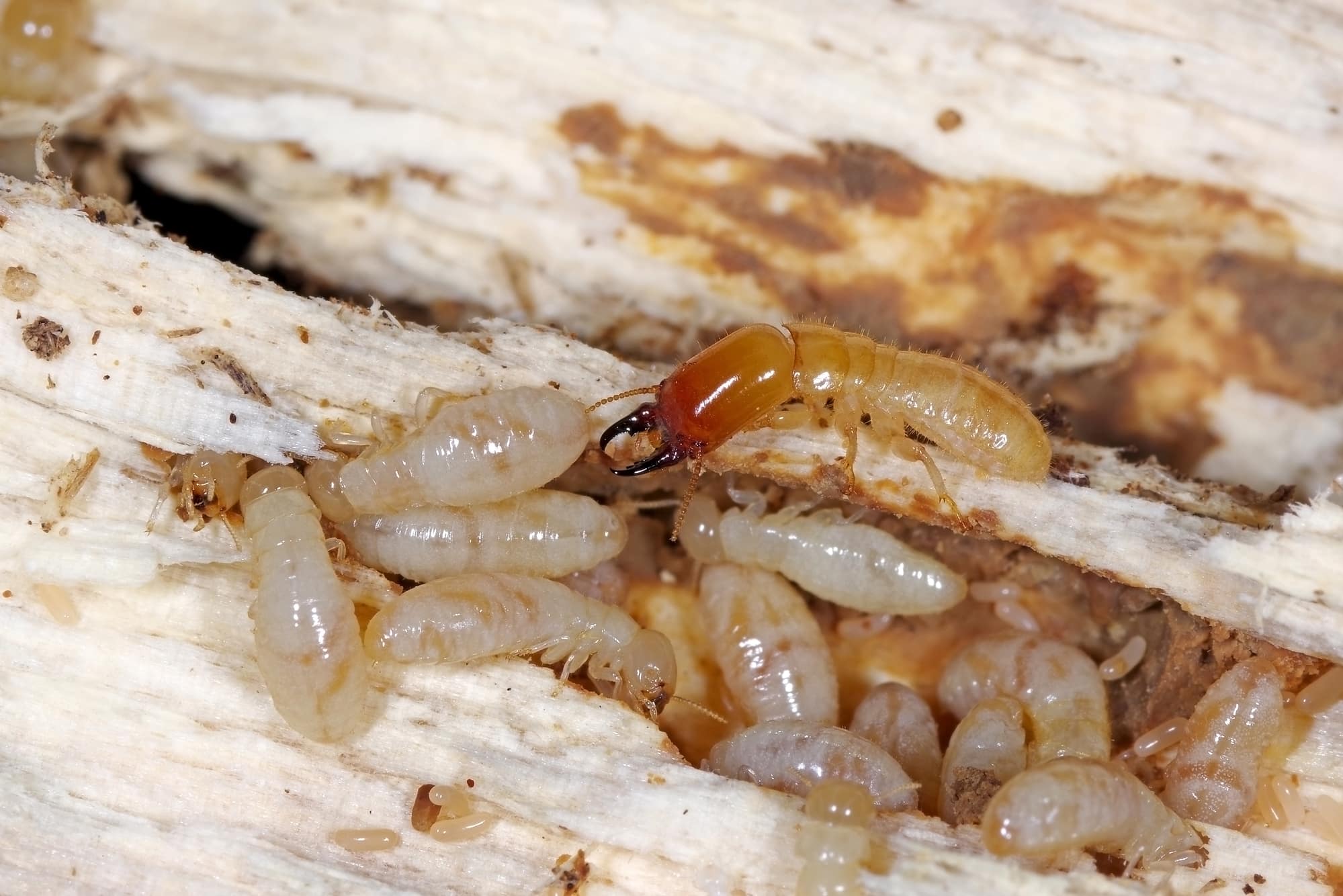Here’s the process you can apply to prevent Dry-wood termites from your home and property.
- Trim plants and vegetation away from your home’s exterior to deny termites easy access.
- Keep firewood, old logs, and tree stumps far from your property.
- Use termite-resistant wood for outdoor structures like decks and fences.
- Opt for raised garden beds made from non-wood materials.
- Replace decaying plants promptly to eliminate termite attractants.
- Ensure good ventilation in areas like attics, basements, and crawl spaces to reduce moisture buildup.
If you’re a homeowner, the last thing you want is uninvited guests like dry wood termites causing havoc in your house. In this blog post, I’ll delve into the world of dry wood termites, exploring their characteristics and risks. So, let’s get Started.
What are Drywood Termites?

Drywood termites are a specific insect type that eats dry wood and doesn’t need soil to live. They live inside the wood they munch on, causing damage to buildings.
A. Characteristics and Habits of Drywood Termites:
Appearance: Drywood termites are small, usually about 3/8 inch long. They are pale and may have a reddish-brown head.
Wood-Dwellers: Unlike their soil-dwelling cousins, dry wood termites don’t need contact with the ground. They live inside the wood they infest.
Tunnel Craftsmen: These termites create intricate tunnels and chambers within the wood, slowly consuming it from the inside out.
Year-Round Activity: Drywood termites are active throughout the year, making them a constant threat.
B. Risks Associated with Drywood Termite Infestation:
Structural Damage: Once inside your home, dry wood termites can wreak havoc on your wooden structures. They chew through beams, furniture, and even flooring, potentially causing significant damage.
Financial Burden: Treating a dry wood termite infestation can be costly. Repairing damaged wood adds to the financial strain.
Property Value Decline: A termite infestation can decrease the value of your property. When it’s time to sell, potential buyers may be deterred by the termite history.
Now that you understand the enemy let’s move on to the proactive steps you can take to prevent dry wood termites from infiltrating your home.
How to Prevent Drywood Termites?
Preventing dry wood termites from your property is undoubtedly a challenging but important task. You must’ve already tried all the possible dry wood termite repellent; still, it’s in your house, right?
In that case, you can use our unique ideas for preventing dry-wood termites from your area.
- Termiticide Paint: Consider using termiticide-infused paint for your wooden structures. This paint contains chemicals that deter termites.
- Solar-Powered Fans: Install solar-powered attic fans to reduce humidity in your attic. Termites are less attracted to dry environments.
- Termite-Resistant Furniture: Invest in furniture made from termite-resistant materials, such as metal or plastic, to minimize the risk of infestation.
- Mulch Alternatives: Replace traditional wood mulch with gravel or rubber mulch in your garden beds to create an unattractive environment for termites.
- Repellent Plants: Plant termite-repellent species like mint, citronella, or chrysanthemums around your home to act as natural deterrents.
- Electronic Termite Detection: Use electronic termite detection systems that can monitor termite activity and alert you when termites are present.
- Termite-Eating Predators: Encourage natural predators of termites, like certain species of birds or nematodes, in your garden to help control termite populations.
Identifying Signs of Drywood Termites in Your House
When it comes to keeping your home termite-free, knowing how to spot the signs of drywood termites is crucial. In this section, I’ll explore common signs that indicate their presence and offer practical tips on conducting thorough inspections of your property.
A. Common Signs of Drywood Termites:
Tiny Holes in Wood:
Keep an eye out for small, round holes in wooden surfaces. These holes are often the entry and exit points for drywood termites.
Wood Pellet-Like Droppings:
Look for tiny piles of pellet-shaped termite droppings, also known as frass. These may accumulate near infested wood.
Discarded Wings:
After swarming, drywood termites shed their wings. Finding discarded wings around windowsills or light fixtures can signify an infestation.
Hollow-Sounding Wood:
Tap on wooden surfaces. If they sound hollow, it could indicate termite damage within the wood.
B. Tips on How to Conduct a Thorough Inspection:
Start with the Exterior:
Begin your inspection on the outside of your home.
Look for cracks in the foundation, openings around doors and windows, and signs of termites on wooden structures like decks or fences.
Move Inside:
Continue the inspection indoors. Examine wooden furniture, beams, and flooring for signs of termite infestation. Pay close attention to areas with wooden paneling for ceilings.
Use a Flashlight:
A flashlight can be your best friend during inspections. It helps you see into dark corners and crevices where termites may be hiding.
Probe Suspect Areas:
If you think there might be termites in the wooden furniture of your house, use a screwdriver or similar tool to check the wood gently. Soft or damaged wood may indicate an infestation.
Check Attics and Crawl Spaces:
Don’t forget to inspect attics, crawl spaces, and basements. These areas often provide access points for termites.
Landscape and Foundation Protection against the Drywood Termites
Preventing drywood termites from entering your home begins with safeguarding your property’s perimeter and making wise landscaping choices. In this section, I’ll explore practical measures to keep termites at bay and suggest landscaping options that deter these pests.
A. Preventing Termites from Entering Your Property:
Maintaining a Termite-Free Perimeter Around Your Home:
Keep a clear zone: Create a barrier of at least 6 inches between your home’s foundation and mulch, plants, or wood chips.
Trim vegetation: Regularly trim shrubs and plants near your house, ensuring they don’t touch the exterior walls. Termites can use plant branches as bridges to enter your home.
Remove wood debris: Eliminate old logs, tree stumps, and deadwood from your yard. These are prime targets for termites and could serve as entry points.
Treating Wooden Structures and Landscaping Materials:
Use treated wood: If you’re building or replacing structures like decks or fences, opt for pressure-treated wood, which is less appealing to termites.
Apply termite-resistant coatings: Apply termite-resistant coatings or treatments to wooden structures like sheds or playsets to prevent termite infestations.
B. Landscaping Choices that Deter Termites:
Use Termite-Resistant Plants: Some plants, like rosemary, marigolds, and lavender, are naturally repellent to termites. Plant them strategically around your home’s perimeter.
Avoid Wood Mulch: While wood mulch may look nice, it can attract termites. Consider alternatives like rubber mulch or gravel for landscaping.
Rock Barriers: Creating a barrier of small rocks or gravel around the foundation can discourage termites from approaching your home.
Raised Garden Beds: If you have garden beds close to your home, consider raised beds made of materials other than wood, like stone or metal.
Regular Maintenance: Keep your landscaping well-maintained. Remove dead plants and replace them promptly, as decaying plant matter can attract termites.
Building Maintenance and Termite Prevention

Introduction: Keeping your home free from dry-wood termites requires regular maintenance and vigilant prevention measures.
In this section, I’ll guide you through essential maintenance practices to prevent termite infestations and provide tips for ensuring effective termite barriers and preventive treatments.
A. Regular Maintenance Practices to Prevent Termite Infestations:
Sealing Cracks and Gaps in the Home’s Structure:
- Check for cracks and gaps in your home’s foundation, walls, and roof.
- Seal these openings with caulk or weatherstripping, especially where pipes and wires enter your home.
- By sealing these gaps, you deny termites potential entry points into your home.
Proper Ventilation to Reduce Moisture Accumulation:
- Ensure your home has proper ventilation in areas like the attic, basement, and crawl spaces.
- Use exhaust fans in bathrooms and your kitchens to lower humidity.
- Termites like moisture, so good ventilation keeps them away.
B. Tips for Ensuring Effective Termite Barriers and Preventive Treatments:
Regular Inspections: Schedule regular termite inspections by a pest control professional. They can identify early signs of infestation and recommend preventive measures.
Termite Barriers: Consider installing physical termite barriers, like steel mesh or sand, around the foundation of your home. These barriers make it difficult for termites to access your property.
Chemical Treatments: Consult with a pest control expert to apply chemical treatments around your home’s perimeter. These treatments create a protective barrier against termites.
Wood Treatment: If you have wooden structures in your home, such as beams or supports, consider treating them with termite-resistant coatings or chemicals.
Regular Maintenance of Treatments: If you have existing termite barriers or treatments in place, make sure they are regularly maintained and re-applied as needed.
Wood Treatment and Protection for Treating Drywood Termites Issue
When it comes to protecting your home from drywood termites, proactive wood treatment is a critical step.
In this section, I’ll explore wood treatment options that can safeguard your property against these pests. We’ll discuss the use of borates and other wood preservatives and emphasize the importance of regular inspections and retreatment.
A. Wood Treatment Options to Safeguard Against Drywood Termites:
Use of Borates and Other Wood Preservatives:
- Borates: Borates are naturally occurring minerals that are highly effective against drywood termites. They can be applied to wood surfaces as a treatment.
- Borate Solutions: Borate solutions can be sprayed or brushed onto exposed wood surfaces, creating a protective barrier. These solutions are readily available and easy to apply.
- Pressure Treatment: For new construction or when replacing wood, consider using pressure-treated wood infused with borates. This type of wood is resistant to termite infestations.
Importance of Regular Inspections and Retreatment:
Regular Inspections: Even with wood treatments in place, it’s crucial to schedule regular termite inspections by a pest control professional. They can detect any signs of termite activity early.
Retreatment: Over time, the effectiveness of wood treatments may diminish. To ensure ongoing protection, be prepared for periodic retreatment as the product manufacturer or pest control expert recommends.
Maintain Records: Keep records of the dates of treatment and inspections so that you can stay on top of your termite prevention efforts.
Wood treatment with substances like borates and other wood preservatives can provide a strong defense against drywood termites. Remember, proactive wood protection is key to your overall termite prevention strategy.
FAQs
What are drywood termites, and why are they a concern?
Drywood termites are wood-destroying insects that can damage homes. They’re a concern because they can silently eat through wood, potentially causing structural issues.
How can I prevent drywood termite infestations?
To prevent drywood termite infestations, employ annual inspections, seal cracks, reduce moisture, choose termite-resistant wood, and consider professional pest control services for a comprehensive defense plan.
Do drywood termites target specific areas in the home?
No, drywood termites can infest various wooden areas throughout the home, including furniture, beams, flooring, and walls.
Can termite-resistant building materials help prevent infestations?
Yes, termite-resistant building materials can significantly help prevent termite infestations by making it more challenging for termites to damage the structure.
Are there natural deterrents against drywood termites?
Yes, certain natural deterrents like cedar and cypress wood, as well as planting termite-repelling plants like mint and chrysanthemums, can help deter drywood termites.
Is firewood storage near the house a concern?
Yes, storing firewood near the house can be a concern as it can attract drywood termites closer to your home, increasing the risk of infestation.
How important is regular home maintenance in prevention?
Regular maintenance, including inspections for leaks, wood decay, and damaged paint, helps spot early signs of termite activity.
Can chemical treatments prevent drywood termites?
Yes, chemical treatments, such as termiticides applied to the soil or directly to wood, can effectively prevent and control drywood termite infestations.
How often should I inspect my home for drywood termites?
You should Inspect your home for drywood termites at least once a year, ideally during the spring or early summer, as this is when termite swarming typically occurs.
Are there DIY methods to help prevent drywood termites?
Yes, there are several DIY methods to help prevent drywood termites, such as sealing cracks and gaps, using termite-resistant wood, and applying borate treatments.
However, professional inspections should still be conducted annually for thorough prevention.
Conclusion
Drywood termites can cause significant damage to our homes and structures. To prevent drywood termite infestations, it is essential to regular inspections, seal any cracks or openings, avoid moisture buildup, and maintain proper ventilation.
Preventive measures such as using treated wood and termite repellents can also be effective.
Doing these things helps prevent termite damage and keep our property safe. Safeguarding our homes against drywood termites is crucial for our safety and overall well-being.

